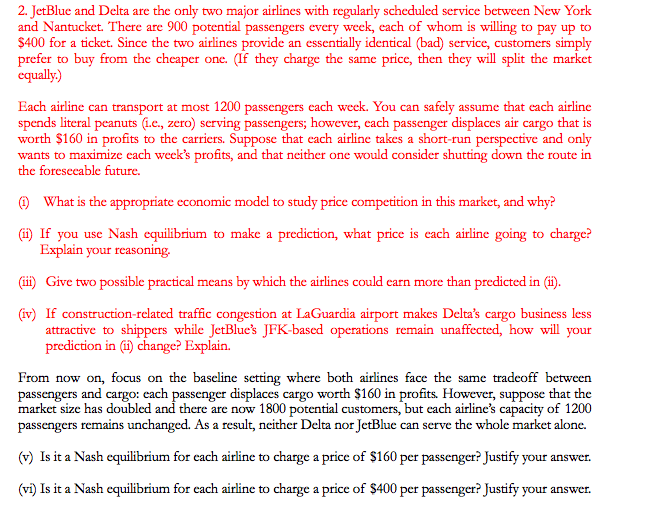2. JetBlue and Delta are the only two major airlines with regularly scheduled service between New York and Nantucket. There are 900 potential passengers every week, each of whom is willing to pay up to $400 for a ticket. Since the two airlines provide an essentially identical (bad) service, customers simply prefer to buy from the cheaper one. (If they charge the same price, then they will split the market equally.) Each airline can transport at most 1200 passengers each week. You can safely assume that each airline spends literal peanuts (i.e., zero) serving passengers; however, each passenger displaces air cargo that is worth $160 in profits to the carriers. Suppose that each airline takes a short-run perspective and only wants to maximize each week's profits, and that neither one would consider shutting down the route in the foreseeable future. (1) What is the appropriate economic model to study price competition in this market, and why? (i) If you use Nash equilibrium to make a prediction, what price is each airline going to charge? Explain your reasoning. (iii) Give two possible practical means by which the airlines could earn more than predicted in (ii).
2. JetBlue and Delta are the only two major airlines with regularly scheduled service between New York and Nantucket. There are 900 potential passengers every week, each of whom is willing to pay up to $400 for a ticket. Since the two airlines provide an essentially identical (bad) service, customers simply prefer to buy from the cheaper one. (If they charge the same price, then they will split the market equally.) Each airline can transport at most 1200 passengers each week. You can safely assume that each airline spends literal peanuts (i.e., zero) serving passengers; however, each passenger displaces air cargo that is worth $160 in profits to the carriers. Suppose that each airline takes a short-run perspective and only wants to maximize each week's profits, and that neither one would consider shutting down the route in the foreseeable future. (1) What is the appropriate economic model to study price competition in this market, and why? (i) If you use Nash equilibrium to make a prediction, what price is each airline going to charge? Explain your reasoning. (iii) Give two possible practical means by which the airlines could earn more than predicted in (ii).
Managerial Economics: A Problem Solving Approach
5th Edition
ISBN:9781337106665
Author:Luke M. Froeb, Brian T. McCann, Michael R. Ward, Mike Shor
Publisher:Luke M. Froeb, Brian T. McCann, Michael R. Ward, Mike Shor
Chapter16: Bargaining
Section: Chapter Questions
Problem 16.1IP
Related questions
Question

Transcribed Image Text:2. JetBlue and Delta are the only two major airlines with regularly scheduled service between New York
and Nantucket. There are 900 potential passengers every week, each of whom is willing to pay up to
$400 for a ticket. Since the two airlines provide an essentially identical (bad) service, customers simply
prefer to buy from the cheaper one. (If they charge the same price, then they will split the market
equally.)
Each airline can transport at most 1200 passengers each week. You can safely assume that each airline
spends literal peanuts (i.e., zero) serving passengers; however, each passenger displaces air cargo that is
worth $160 in profits to the carriers. Suppose that each airline takes a short-run perspective and only
wants to maximize each week's profits, and that neither one would consider shutting down the route in
the foreseeable future.
(1) What is the appropriate economic model to study price competition in this market, and why?
(ii) If you use Nash equilibrium to make a prediction, what price is each airline going to charge?
Explain your reasoning.
(iii) Give two possible practical means by which the airlines could earn more than predicted in (ii).
(iv) If construction-related traffic congestion at LaGuardia airport makes Delta's cargo business less
attractive to shippers while JetBlue's JFK-based operations remain unaffected, how will your
prediction in (i) change? Explain.
From now on, focus on the baseline setting where both airlines face the same tradeoff between
passengers and cargo: each passenger displaces cargo worth $160 in profits. However, suppose that the
market size has doubled and there are now 1800 potential customers, but each airline's capacity of 1200
passengers remains unchanged. As a result, neither Delta nor JetBlue can serve the whole market alone.
(v) Is it a Nash equilibrium for each airline to charge a price of $160 per passenger? Justify your answer.
(vi) Is it a Nash equilibrium for each airline to charge a price of $400 per passenger? Justify your answer.
Expert Solution
This question has been solved!
Explore an expertly crafted, step-by-step solution for a thorough understanding of key concepts.
This is a popular solution!
Trending now
This is a popular solution!
Step by step
Solved in 2 steps

Knowledge Booster
Learn more about
Need a deep-dive on the concept behind this application? Look no further. Learn more about this topic, economics and related others by exploring similar questions and additional content below.Recommended textbooks for you

Managerial Economics: A Problem Solving Approach
Economics
ISBN:
9781337106665
Author:
Luke M. Froeb, Brian T. McCann, Michael R. Ward, Mike Shor
Publisher:
Cengage Learning


Managerial Economics: Applications, Strategies an…
Economics
ISBN:
9781305506381
Author:
James R. McGuigan, R. Charles Moyer, Frederick H.deB. Harris
Publisher:
Cengage Learning

Managerial Economics: A Problem Solving Approach
Economics
ISBN:
9781337106665
Author:
Luke M. Froeb, Brian T. McCann, Michael R. Ward, Mike Shor
Publisher:
Cengage Learning


Managerial Economics: Applications, Strategies an…
Economics
ISBN:
9781305506381
Author:
James R. McGuigan, R. Charles Moyer, Frederick H.deB. Harris
Publisher:
Cengage Learning